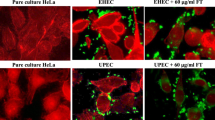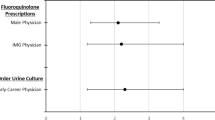Abstract
There were three objectives to the present study: (1) compare the bladder infection rate and extent of biofilm formation for seven untreated spinal cord injured (SCI) patients and seven given prophylactic co-trimoxazole, (2) identify a level of bacterial adhesion to bladder cells which could be used to help predict symptomatic infection, and (3) determine from in vivo and in vitro studies whether fluoroquinolones were effective at penetrating bacterial biofilms. The results showed that the infection rate had not changed with the introduction of prophylaxis. However, the uropathogenic population had altered subsequent to the introduction of prophylaxis with E. coli being replaced by E. faecalis as the most common cause of infection. In 63% of the specimens from asymptomatic patients, the bacterial counts per cell were < 20, while 81% of specimens from patients with at least one sign and one symptom of urinary tract infection (UTI) had > 20 adherent bacteria per bladder cell. Therefore, it is proposed that counts of > 20 bacteria adherent to sediment transitional epithelial bladder cells may be predictive of symptomatic UTI. Clinical data showed that fluoroquinolone therapy reduced the adhesion counts to < 20 per cell in 63% of cases, while trimethoprim-sulfamethoxazole only did so in 44%. Further in vitro testing showed that ciprofloxacin (0.1, 0.5 and 1.0 μg/ml) partially or completely eradicated adherent biofilms from 92% of spinal cord injured patients' bladder cells, while ofloxacin did so in 71% cases and norfloxacin in 56%. These findings have important implications for the detection and treatment of bacteriuria in spinal cord injured patients.
Similar content being viewed by others
Log in or create a free account to read this content
Gain free access to this article, as well as selected content from this journal and more on nature.com
or
References
Stover S L, Lloyd L K, Waites K B, Jackson A B (1989) Urinary tract infection in spinal cord injury. Arch Phys Med Rehabil 70: 47–55.
National Institute of Disability and Rehabilitation Research Consensus Statement (1992) The prevention and management of urinary tract infections among people with spinal cord injuries. J Am Paraplegia Soc 15: 194–204.
Reid G, Charbonneau-Smith R, Lam D et al (1992) Bacterial biofilm formation in the urinary bladder of spinal cord injured patients. Paraplegia 30: 711–717.
Reid G, Kang Y S, Lacerte M et al (1993) Bacterial biofilm formation on the bladder epithelium of spinal cord injured patients. II. Toxic outcome on cell viability. Paraplegia 31: 494–499.
Reid G, Denstedt J D, Kang Y S et al (1992) Bacterial adhesion and biofilm formation on ureteral stents in vitro and in vivo. J Urol 148: 1592–1594.
Nicolle L E, Harding G K M, Thomson M et al (1988) Efficacy of five years of continuous, low-dose trimethoprim-sulfamethoxazole prophylaxis for urinary tract infection. J Infect Dis 157: 1239–1242.
Reid G, Tieszer C, Foerch R et al (1993) Adsorption of ciprofloxacin to urinary catheters and effect on subsequent bacterial adhesion and survival. Colloids Surfaces B: Biointerfaces 1: 9–16.
Nikolov R, Khoury A E, Bruce A W, DiCosmo F (1993) Interaction of ciprofloxacin loaded liposomes with Pseudomonas aeruginosa cells. Cells Materials 3: 321–326.
Matsumoto T, Kumazawa J (1989) Significance of enterococci in chronic complicated urinary tract infection. In Kass EH, Svanborg Eden C, editors. Host-parasite Interactions in Urinary Tract Infections. University of Chicago Press, Chicago: 194–197.
Svanborg Eden C, Hanson L A, Jodal U et al (1976) Variable adherence to normal human urinary-tract epithelial cells of Escherichia coli strains associated with various forms of urinary-tract infection. Lancet 2: 490–492.
Pfau A, Sacks T G (1993) Single dose quinolone treatment in acute uncomplicated urinary tract infection in women. J Urol 149: 532–534.
Author information
Authors and Affiliations
Rights and permissions
About this article
Cite this article
Reid, G., Dafoe, L., Delaney, G. et al. Use of adhesion counts to help predict symptomatic infection and the ability of fluoroquinolones to penetrate bacterial biofilms on the bladder cells of spinal cord injured patients. Spinal Cord 32, 468–472 (1994). https://doi.org/10.1038/sc.1994.74
Issue date:
DOI: https://doi.org/10.1038/sc.1994.74



